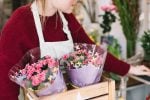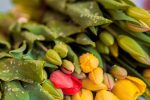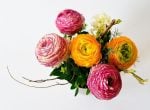When I walked into my friend’s flower shop last week, she looked exhausted. “I can’t keep up,” she confessed, sorting through wilted roses and unsold calla lilies. “I stock what I think will sell, listing popular types of flowers, but customers walk out empty-handed, sometimes seeking specific purple flowers or other bright flowers I don’t have.”
This conversation reveals a painful truth: even experienced florists struggle to predict which beautiful flowers will fly off shelves and which cut flowers will sit until they’re destined for the compost bin. Customers might be looking for anything from cheerful blooms to specific trumpet-shaped flowers.
But what if the difference between profit and loss isn’t just about working harder—it’s about stocking smarter, considering factors like vase life and the appeal of fragrant flowers?
In 2025, the floral industry faces unique challenges. Climate shifts affect growing seasons for many flowering plants. Consumer preferences evolve faster than ever, demanding variety, from traditional floral arrangements to novelties like star-shaped flowers. And with profit margins tightening, every purchasing decision for your flower arrangements counts, especially when deciding which colorful flowers to feature.
I’ve spent the past six months interviewing top florists across the country who consistently outperform their competitors. Their secret? A strategic approach to inventory that balances timeless favorites, like the ever-popular gerbera daisy, with emerging trends and understanding which popular types of flowers truly resonate. They know which flowers bloom when, ensuring freshness.
The findings might surprise you, touching on everything from the importance of dark green foliage in floral bouquets to the rising demand for blooms sourced from North America.
Whether you run a small street-corner shop or manage a chain of stores, the types of flowers you choose to stock directly impact your bottom line. The right selection—including stunning flowers with a long vase life—attracts customers, drives sales, and builds your reputation in the competitive flower world. Offering variety, maybe even some daisy like flowers or elegant flower options, can make a difference. For florists looking to boost their sales, understanding how to leverage popular flowers is crucial. Strategic promotion of in-demand blooms can attract more buyers and increase customer loyalty. By focusing on flowers that resonate with your target market and marketing them effectively, you can transform your inventory into a powerful sales driver. Learn practical tips and strategies in our comprehensive guide on leveraging popular flowers to maximize your business potential.
In this guide, I’ll share exactly which flowers deserve space in your cooler this year. We’ll cover popular flowers, including some showy flowers and delicate flowers. No guesswork. No trends like fleeting demands for specific blue flowers that fade before you can restock. Just practical advice for florists who want to thrive in 2025, ensuring they have the vibrant blooms customers desire.
Ready to transform your inventory from a source of stress to your strongest competitive advantage?
Metrobi drivers are rated 4.97/5
Trusted by local businesses for:
- Background-checked professionals
- Specialized in business deliveries
- Same drivers for consistency
- 4.97/5 average delivery rating
Most Popular Flowers Florists Sell in 2025
The floral industry continues to thrive in 2025, with certain flower varieties remaining consistently popular among customers. This growth highlights the steady demand for quality floral products across the country.
Let’s look at the top three flowers that every professional florist should keep in stock this year.
1. Roses
Roses remain the cornerstone of any successful floral business in 2025. Their status as the symbol of love makes them essential for:
Wedding bouquets and centerpieces
Valentine’s Day and anniversary celebrations
Every day romantic gestures
What makes roses particularly valuable for florists is their year-round availability in countless colors. From classic red to trendy pastels, roses offer something for every customer preference. Market data shows that roses are the preferred choice for major occasions like Valentine’s Day and Mother’s Day, especially among baby boomers.
Rose Market Dominance: Roses account for over 41.8% of the global cut flower market revenue, with more than 20 billion rose stems produced annually.
2. Lilies
Lilies continue to be a top seller due to their striking appearance and sweet fragrance. Their versatility makes them perfect for:
Sympathy arrangements and funeral flowers
Elegant centerpieces for formal events
Mixed bouquets where a statement flower is needed
The variety of lily types available—including Asiatic, Oriental, and Calla—gives florists flexibility in design and price points. Their long vase life also makes them popular among customers who want lasting arrangements.
3. Tulips
Tulips round out the top three with their clean lines and vibrant colors. They excel as:
Spring seasonal favorites
Easter and Mother’s Day staples
Minimalist single-variety bouquets
Their distinctive shape works well in both traditional and modern designs. While most popular during spring, year-round greenhouse production means tulips can be stocked consistently. Their affordable price point also makes them accessible to a wide range of customers.
Tulip Bulb Production: The Netherlands produces between 8.5 and 9 billion flower bulbs annually, with tulips being a significant portion.
When considering the most commonly used flowers in bouquets, the rule of odd numbers often applies. Many florists follow the “rule of 3” in floral design, creating visual interest through asymmetry rather than perfect balance. This approach makes arrangements look more natural and appealing.
Must-Have Popular Types of Flowers for Florists
Stock these three essential flowers to meet customer demand year-round
Balance seasonal availability with consistent offerings
Each flower serves specific design needs and market segments
Beyond the top-selling blooms, every successful florist needs a core selection of versatile flowers that satisfy different customer needs. These must-have varieties complement your bestsellers and ensure you can meet diverse design requirements throughout the year.
1. Sunflowers
Sunflowers stand out as essential stock for any florist in 2025. These bright yellow blooms immediately communicate joy and warmth, making them perfect for cheerful arrangements. Their distinctive appearance creates instant recognition with customers.
Most florists find sunflowers particularly valuable during summer months when demand peaks. Their large heads provide substantial visual impact, while their strong stems make them durable in arrangements.
What makes sunflowers truly essential is their versatility. They work beautifully as focal points in rustic arrangements, complement country-style wedding designs, and add a dramatic touch to sympathy pieces. Their bold color contrasts effectively with purple complementary flowers like lavender or delphinium, creating arrangements with strong visual interest and balance.
2. Orchids
Orchids represent the luxury segment of any florist’s inventory. Their exotic appearance and longer vase life justify their higher price point, making them essential for premium offerings in 2025.
Orchid Longevity: Phalaenopsis orchids can bloom for six to ten weeks, with proper care extending the bloom period.
While orchids require specific care—careful handling, proper humidity, and stable temperatures—their ability to satisfy high-end clients makes them worth the extra attention. Most commercial florists stock phalaenopsis (moth) orchids as their standard variety, but expanding to include cymbidium and dendrobium orchids allows for more design flexibility.
This growth trend is expected to continue through 2025, particularly in urban markets and for special occasions like anniversaries and corporate gifts.
Orchid Market Growth: The global orchid market was valued at USD 302.5 million in 2024 and is projected to grow at a CAGR of 4.00% from 2024 to 2031.
Care Requirements
Orchids need specialized care both in your shop and in customer homes. Their longevity depends on proper handling, making education an important part of selling these premium flowers. Most orchid varieties prefer indirect light, moderate humidity, and temperatures between 65-75°F (18-24°C).
When receiving orchid shipments, inspect them immediately for damage and store them separately from ethylene-producing fruits or flowers, which can cause premature wilting. In arrangements, give orchids adequate water sources through floral foam or water tubes.
3. Peonies
Peonies embody everything that makes seasonal flowers special. Their lush, full blooms create arrangements that feel abundant and luxurious. Despite their limited availability (typically May through June in most regions), peonies remain one of the most requested flowers for weddings and special events throughout 2025.
The limited seasonal window for fresh peonies actually works to florists’ advantage in two ways. First, it creates anticipation and excitement when they come into season. Second, it allows florists to charge premium prices during peak availability.
Peonies blend beautifully with other premium flowers. Their soft, rounded form contrasts nicely with the structure of roses and the linear qualities of lilies. This compatibility makes them valuable for mixed arrangements even when they’re not the focal point. Their subtle fragrance adds another sensory dimension to designs.
Essential Floral Supplies for 2025
Beyond the flowers themselves, every florist needs reliable tools and materials. The right supplies ensure efficiency, quality, and profitability. These essentials complement your flower inventory to create a complete operation.
Quality cutting tools top the list of necessary supplies. Professional-grade shears, knives, and clippers make precise cuts that extend flower life. Most successful florists maintain multiple sets of tools to avoid cross-contamination between flower types and reduce the spread of bacteria.
Floral preservatives remain fundamental despite advances in flower breeding. Both holding solutions (for your shop) and consumer packets (for customers) represent small investments with significant returns.
Design elements like floral foam, chicken wire, and tape form the structural foundation of arrangements. While sustainable alternatives to traditional floral foam gain popularity in 2025, having various mechanics options allows flexibility in design approaches.
Water-handling equipment, including buckets, vases, and clean water sources, directly impacts flower longevity. Professional florists invest in antimicrobial containers and regular cleaning protocols to prevent bacterial growth that shortens bloom life.
Pots and Planters Market Size: The global pots and planters market size was valued at USD 1.05 billion in 2022 and is expected to reach USD 1.37 billion by 2028.
Packaging materials complete the essential supply list. Quality boxes, tissue paper, ribbons, and cards not only protect arrangements during delivery but also enhance the customer experience. Branded packaging builds recognition and perceived value for your business.
Trending Flower Varieties 2025: What’s Hot This Year
Market shifts toward eco-conscious flowers with local sourcing
Unusual colors and preserved flowers dominate arrangements
Seasonal buying patterns reveal opportunities for smart stocking
1. Sustainable and Eco-Friendly Choices
The past 12 months have shown remarkable growth in customer demand for sustainable flowers.
By March 2024, the trend had gained such momentum that major suppliers began offering “origin tracking” for their stock. This system allows florists to see exactly where their flowers came from and share this information with customers.
Summer 2024 brought significant shifts in growing practices. More flower farms switched to organic methods. This change was driven by consumer demand and supported by new farming technologies that made organic growing more cost-effective.
Regional Sourcing Patterns
The fall and winter months of 2024 revealed interesting regional patterns. Northeast florists found local greenhouse-grown flowers particularly profitable. Western states saw strong customer preference for drought-resistant varieties, reflecting growing climate awareness. Southern regions experienced increased demand for native species that support local pollinators.
By December 2024, the data showed that florists who actively promoted their sustainable practices saw higher holiday sales than those who didn’t. This wasn’t just about sourcing—it extended to packaging, delivery methods, and shop operations.
For the next 12 months, this trend will intensify. We’ll see more certification programs for sustainable floristry and growing consumer knowledge about flower origins. Smart florists should invest in staff training about sustainable practices, create clear in-store and online messaging about sourcing, and develop relationships with local growers now before competition increases.
2. Unique and Unusual Colors
The color revolution in floristry gained serious momentum in early 2024.
Spring 2024 marked a turning point in consumer preferences. Particularly popular were blue roses, black calla lilies, and purple sunflowers.
Summer brought experimental combinations into the mainstream. Particularly popular were gradients and ombré effects.
Consumer Psychology and Color Choices
Fall 2024 research revealed interesting insights about why this trend is gaining ground.
By winter 2024, the data showed clear patterns in what works. The most successful shops created “color stories” that combined unusual flowers with complementary traditional blooms.
Looking forward to the next year, this trend will become more sophisticated. We’ll see more naturally bred unusual colors rather than just dyed options. Smart florists should develop a “signature” unusual color palette that sets them apart from competitors, invest in good lighting to showcase these colors effectively, and create educational materials that help customers appreciate the rarity and value of unusual varieties.
3. Dried and Preserved Flowers
This wasn’t just a continuation of previous trends—it represented a significant market shift.
By March, preservation techniques had advanced significantly. New methods that better maintained color vibrancy entered the mainstream market. The ability to maintain more natural-looking flowers expanded the market beyond the typical “rustic” aesthetic.
Summer 2024 brought unexpected growth in the “mixed media” approach—combinations of fresh and preserved elements in the same arrangement. These combinations appealed particularly to customers looking for arrangements with longer lifespans but still wanting the impact of fresh flowers.
Commercial Applications Expand
Fall saw major growth in commercial applications. The cost savings from longer-lasting displays proved attractive to business clients.
The winter holiday season of 2024 cemented this trend. Particularly popular were arrangements that combined preserved flowers with fresh greenery, offering both longevity and the traditional holiday scent customers desired.
Looking to the future, this trend will continue to grow but with greater sophistication. We’ll see more specialized preservation techniques that maintain the look and sometimes even the scent of fresh flowers. Smart florists should develop a preservation service for wedding bouquets and other sentimental arrangements, create subscription models featuring preserved elements that require less frequent replacement, and invest in training to master sophisticated preservation techniques that produce higher-quality results.
Pricing Strategies for Preserved Products
Analysis of the most successful preserved flower businesses revealed key pricing insights.
For the next year, florists should position their preserved offerings as premium products with detailed information about the preservation process and care instructions. The data shows customers value understanding what makes their purchase special and long-lasting. Creating clear comparisons between the lifetime value of preserved versus fresh arrangements can help customers understand the value proposition and justify the higher upfront cost.
Floral Stock Essentials 2025: Adapting to Future Demands
Stock management isn’t static—it requires constant adaptation to meet changing market demands
Understanding design principles and consumer preferences helps florists stay competitive
Data-driven inventory decisions lead to higher profits and customer satisfaction
1. Meaning of the 3 5 8 Rule
The 3 5 8 rule is a fundamental design principle in floristry that focuses on grouping flowers in odd numbers—specifically three, five, or eight stems. This approach creates asymmetry that feels more natural and visually interesting to the human eye. When flowers are arranged in even numbers, they can create a forced sense of symmetry that appears too structured or artificial.
The rule has its roots in classical design theory and the concept of the “golden ratio”, which appears throughout nature and is considered aesthetically pleasing. In floral design, this translates to creating arrangements where elements are distributed in a way that maintains balance while avoiding perfect symmetry.
Implementation in Daily Operations
Putting the 3 5 8 rule into practice requires both staff training and customer education. For your team, conduct regular design workshops where they practice creating arrangements using these groupings. Document the process with before-and-after photos to demonstrate the visual impact. These examples can then become part of your customer education materials.
Create simple instruction cards explaining the rule that can be included with DIY bouquet kits or workshop materials. By positioning your shop as an educational resource on principles like the 3 5 8 rule, you establish expertise that drives customer loyalty.
2. Adapting to Seasonal Changes
Seasonal flexibility forms the backbone of smart inventory management in floristry. Unlike retail sectors with consistent year-round stock, florists must constantly adjust their inventory based on growing seasons, climate conditions, and seasonal customer preferences. This dynamic approach requires both forward planning and adaptability.
The practice of tracking seasonal sales patterns allows you to anticipate demand shifts before they occur. Create detailed spreadsheets categorizing sales by flower type, color, and occasion across different seasons. This data becomes increasingly valuable year after year, revealing patterns that might otherwise go unnoticed. These insights allow for precision ordering that reduces waste and maximizes profit margins.
Seasonal Specials Strategy
Developing a seasonal specials strategy keeps your inventory fresh while creating marketing opportunities. Rather than viewing seasonality as a limitation, treat it as a chance to highlight exclusive, limited-time offerings. Create a 12-month calendar mapping out which seasonal flowers will be featured each month, then build marketing campaigns around these focal points.
Consider implementing a “Flower of the Month” program that highlights seasonal varieties with special pricing or featured designs. This approach turns inventory management into a customer engagement tool. This growth indicates consumers are seeking novel floral experiences, making seasonal specialization a strategic advantage.
Flower Seed Market Value: The global flower seeds market was valued at approximately USD 1.6 billion in 2023 and is anticipated to reach USD 2.3 billion by 2032.
3. Predicting Consumer Preferences
Data-driven prediction of consumer preferences has transformed inventory management from guesswork to strategic planning. Modern florists must combine sales analytics with social listening to stay ahead of trends rather than merely reacting to them.
Point-of-sale systems now offer sophisticated reporting capabilities that can identify emerging preferences before they become obvious. Set up weekly reports tracking which flowers, colors, and arrangement styles are gaining traction. These early indicators allow you to adjust purchasing before competitors recognize the shift.
Social Media as Trend Radar
Social media platforms function as real-time trend indicators for florists willing to pay attention. Beyond monitoring your own engagement metrics, establish a system for tracking broader floral trends across platforms. Create lists of influential floral designers, wedding planners, and home decor accounts, then monitor which flowers they’re featuring prominently.
Track hashtag performance for specific flower varieties using social media analytics tools. When you notice increased engagement around particular blooms, consider this an early warning system for upcoming demand. This approach allows you to stock up on trending varieties before wholesale prices increase due to widespread demand. According to the International Fresh Produce Association, technological advancements including AI and data analytics are improving florists’ ability to predict market changes and make informed stocking decisions.
4. Inventory Management Technology
The digital transformation of inventory management has revolutionized how florists maintain optimal stock levels. Cloud-based inventory systems now enable real-time tracking of perishable products, dramatically reducing waste and improving profitability.
Modern inventory management platforms designed specifically for florists incorporate features like freshness dating, automated reordering based on historical data, and integration with point-of-sale systems. These technologies help maintain the delicate balance between having sufficient stock to meet demand without excessive waste.
Mobile Inventory Solutions
Mobile inventory applications allow staff to update stock levels while processing deliveries or conducting daily freshness checks on the sales floor. This immediate updating prevents the sales of items that may have deteriorated in quality or are allocated to pending orders.
These systems also enable cross-location visibility for florists with multiple shops, allowing for transfer of stock between locations to meet localized demand spikes. For independent florists, consider platforms like Floranext, Curate, or Details Flowers that offer inventory modules specifically designed for floral businesses.
5. Building Resilient Supply Chains
The fragility of global supply chains exposed by recent world events has prompted forward-thinking florists to develop more resilient sourcing strategies. Diversification of suppliers across different growing regions provides insurance against disruptions caused by weather events, transportation issues, or other unforeseen circumstances.
Establishing relationships with multiple suppliers at different scales—from large international wholesalers to local farms—creates a safety net for your inventory needs. This approach not only mitigates risk but also provides access to a wider variety of products.
Direct Farm Relationships
Developing direct relationships with flower farms represents both a risk-management strategy and a marketing advantage. These relationships often provide early access to crops, custom growing options, and more stable pricing structures.
Start by identifying farms within a 100-mile radius of your shop, then expand your network gradually. Many farms welcome regular buyers for tours and planning sessions where you can discuss upcoming needs and crop projections. These relationships also support the growing consumer demand for locally-sourced, sustainable products. Document these farm partnerships in your marketing materials, as consumers increasingly make purchasing decisions based on supply chain transparency and environmental impact.
Building resilient supply chains requires consistent effort but results in a more stable business model that can adapt quickly to changing conditions while maintaining quality and availability standards that keep customers returning.
Frequently Asked Questions (FAQs)
What are the top 3 must-stock flowers for consistent sales year-round?
Roses (for romance/weddings), Lilies (for elegance/sympathy), and Tulips (for spring/color) are consistently top sellers crucial for florists.
How do premium or unique flowers, such as elegant calla lilies, fit into a florist’s strategy?
Premium flowers like calla lilies or orchids cater to the luxury market and special events, justifying higher price points and adding sophistication alongside everyday bestsellers.
Beyond the top sellers, why are flowers like sunflowers or the popular gerbera daisy important for florists to stock?
Flowers like sunflowers and gerbera daisies are essential for their versatility, bright colors, and ability to add visual impact or cheerfulness to arrangements, meeting diverse customer needs for different styles and occasions.
What major trends are shaping florist inventory choices in 2025?
Key trends include growing demand for sustainable and locally-sourced flowers, unique and unusual colors, and the increasing popularity of dried and preserved floral arrangements.
How can florists effectively manage their stock of Beautiful Flowers, considering seasonal changes and design principles?
Florists can manage stock effectively by tracking seasonal sales patterns, offering limited-time seasonal specials, using data to predict preferences, implementing inventory technology, and applying design rules like the 3-5-8 grouping for visual appeal.
Conclusion
Stocking the right types of flowers is both an art and a smart business decision for florists in 2025. From timeless classics like roses and elegant calla lilies (known for their unique funnel shaped flowers) to trending options like dahlia flowers and cheerful gerbera daisy varieties, your inventory choices directly affect your shop’s success. Beyond just having beautiful flowers, understanding the 3-5-8 rule for floral arrangements and staying ahead of seasonal demands—knowing when daffodils bloom in early spring or when aster flowers appear in early fall—will set your business apart. Consider stocking versatile options suitable for both indoor and outdoor gardens or even specialized settings like rock gardens.
As flower preferences continue to shift, your ability to balance reliable sellers with emerging trends will be your competitive edge. Sunflowers bring joy with their bright yellow petals, orchids add luxury, freesia flowers offer a sweet scent appreciated in many wedding bouquets, and peonies create memorable moments. Each versatile flower, whether it’s a classic like the iris from the iris family or something more modern like the African daisy, serves a specific purpose. Pay attention to details like shiny dark green leaves that enhance a beautiful bouquet, or the unique appeal of bell shaped flowers and cup shaped flowers. Don’t forget frilly flowers or those with ruffled petals like some anemone flowers. Exploring distinctive flower options can elevate your arrangements and differentiate your shop in a crowded market. These unique flowers bring character and exclusivity, attracting customers looking for something beyond the usual selections. Integrating uncommon blooms with your staples allows you to craft truly memorable bouquets and cater to niche preferences.
Remember that your inventory isn’t static. It should breathe with the seasons, offering bright pink, bright red, and yellow flowers in early summer, and respond to customer preferences, whether they seek waxy white flowers for elegance or small flowers for delicate work. Consider offering flowering shrubs like azalea flowers or even options from clematis plants, known for their stunning clematis flowers.
The most successful florists in 2025 will be those who listen to their customers (perhaps requesting blooms from tropical and subtropical regions or those known to attract pollinators), watch market trends (like the demand for flowers with long vase life), and aren’t afraid to bring in fresh varieties like the Peruvian lily with its delicate petals alongside the tried-and-true favorites. They might even stock flowers suitable to bloom indoors, catering to houseplant enthusiasts, or understand the significance of a national flower. Catering to demands for specific bright shades and bright colours across the Northern Hemisphere and sometimes even sourcing from warm climates is key.
Your selection of flowering plants and daisy flowers tells your shop’s story. Make it one that resonates with customers seeking everything from fragrant flowers to showy flowers, ensuring they keep coming back season after season for your vibrant flowers. Creating a captivating flower display is more than just arranging blooms; it’s about telling a story that draws customers in and encourages them to make a purchase. A thoughtfully designed display that highlights the natural beauty of your flowers can transform casual browsers into loyal buyers. For actionable tips on how to design eye-catching floral arrangements that boost sales, check out this comprehensive guide on crafting a stunning floral display.













